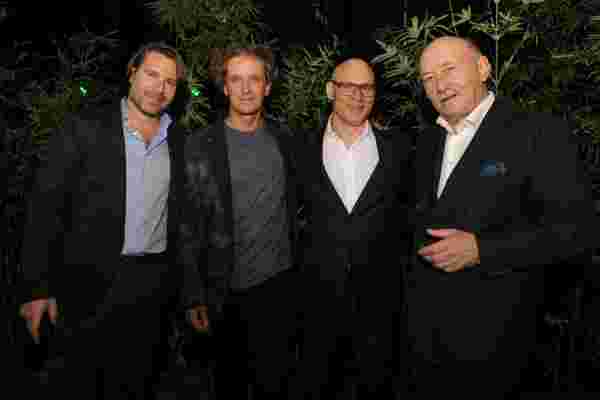August 26,2022
Yves Behar Is Honored with Design Miami’s 2015 Design Visionary Award
by David Stewart
Last year, Design Miami introduced the Design Visionary Award, an honor that recognizes innovators whose contributions propel the globe toward a better future. The 2015 recipient, Yves Behar, is among the world’s most celebrated designers for the progressive ideas he puts to work in all areas of his practice.
To simply call Behar a designer would be insufficient. Since 1999, he and his firm, Fuseproject, have played a direct role in social and environmental change, launching initiatives that envision a more well-rounded future. For nearly ten years Behar has been the chief designer of One Laptop Per Child, a nonprofit that has provided personal laptops to three million children in the developing world, and thanks to his See Better to Learn Better program, half a million children in Mexico receive free prescription glasses each year. Spring, the designer’s latest pursuit , aims to advance entrepreneurial endeavors in Africa that empower young women.
Humanitarian work aside, Behar is known for working collaboratively with a range of brands, from SodaStream to Swarovski. His work has graced the halls of New York’s Museum of Modern Art, Paris’s Centre Pompidou, and the San Francisco Museum of Modern Art, where he serves as artist trustee. In addition to the many other accolades bestowed upon him, Behar was recently named a Top 25 Visionary by Time, while Forbes cited him as the “Most Influential Industrial Designer in the World.”
As Design Miami honors Behar, he discusses with us the principles that helped him arrive where he is today, and where he hopes to go next.

(From left) Design Miami director Rodman Primack, Yves Behar, Design Miami co-founder and co-owner Craig Robins, and Panerai CEO Angelo Bonati at the Design Visionary dinner.
Architectural Digest: What design project are you most proud of, and why?
Yves Behar: For each project I do, I try to surprise myself, do the unexpected, and change my own status quo. From the One Laptop Per Child, the Herman Miller Sayl, or the latest Movado watch collection, there is always an insecurity about being able to do something important. I think each of those projects makes me feel like we have progressed.
AD: What upcoming project are you most excited about?
YB: I’m not allowed to say much about it, but we’re working on a robot that can take care of your baby . . . I can’t say any more, but I will say that it will absolutely transform the way we perceive technology in our lives. Some more near-term projects include a small travel charger with Zolt, and some more watches with Movado.
AD: If you could collaborate with any designer, living or dead, who would it be and why?
YB: I’d have to say Ray and Charles Eames; their work style was famously meticulous, and based equally in aesthetics and technology.
AD: For a firm that is represented in such a wide array of fields, what are the foundational principles in the work of fuseproject?
YB: First and foremost, our work is about big ideas. Design accelerates the adoption of new ideas. And many of these ideas are important for designers to show that there is a way. When you see things through that lens, you realize it applies to any industry and any form of design.
AD: How has the relationship between design and social progress changed since you entered the field?
YB: Ten years ago, the thought of design being a solution to global problems was not obvious. The role of the designer, however, is to create efficiency and to add intentionality to the core of any new service or product. Of course, when you look at nonprofits, efficiency and intentionality are foundational qualities! It is now the designer’s role—and obligation—to prioritize this kind of work, and to help push for-profit businesses to create positive social change.
AD: What do you anticipate the future of sustainable design to look like?
YB: I imagine a future with no waste; material innovations have already become exponentially more vast, and I do think the future needs to be cradle to cradle. If designed properly, one product could be used for many years before needing to be recycled, or its components reused. It’s this kind of design—keeping things relevant so that you don’t need to constantly throw things away—that I hope to become more standardized in the future.
AD: How can other designers use their work to empower social change?
YB: It is in our approach to design that we empower change of any kind—making our work as efficient as possible, as sustainable as possible, filling some kind of need in our lives. These qualities will always shine, and impact us in some way.
AD: What is influencing your work the most right now?
YB: I am extraordinarily fascinated by the future of technology. We are in the early infancy of technology, and we have an opportunity to guide how technology develops and integrates into our lives. I talk a lot about the “invisible interface,” or the idea that we can utilize technology without being absorbed into a screen.
AD: How do you foresee your work being impacted by this award?
YB: It’s not very often we are given the opportunity to design a One Laptop Per Child program, or VerBien eyeglasses for Mexico, or an accelerator program like Spring. This is why I do what I do—to see design make tangible change in the world. Aside from the recognition that our work is making an impact, and that this is the right way to approach design, I do hope that more opportunities for social change will come to our door. And overall the best satisfaction I get as a designer, and as a human being, is when our work is used as an example to start something that makes a difference.






